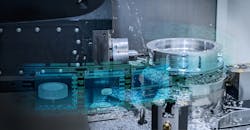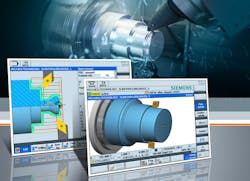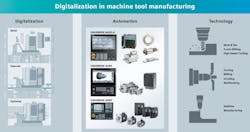Digitalization and the Future of Machining
Digitalization sounds like a word straight out of the “Tron” movies: the representation of an object or process in the virtual world so that one can simulate movement, predict actions, and provide better insight. Digitalization is a growing trend in the industrial space, and the process finding its way into every corner of the factory floor.
What is Digitalization?
“Digitalization is set to fundamentally transform and advance the machine tool industry,” said Dr. Wolfgang Heuring, CEO of the Siemens Motion Control business unit. “By linking the digital and real worlds, we will be able to open up new, significant possibilities for boosting productivity and developing totally new business models.
“This applies both to those who build and use machines,” he continued. “And it applies just as much to small- and medium-sized enterprises as it does to the big players in the industry. Digitalization is the main driver of growth and profitability in the machine tool industry, both locally and worldwide.”
Digitalization of machines involves the massive collection of data. Sensor points attached to the ends of machine tools (such as CNC machines) collect data on vibrations, forces, and temperatures. DMG Mori, for example, has been working with Schaeffler to develop The CELOS Condition Analyzer App in conjunction with an I4.0 sensor pack to monitor machines.
The data collected is forwarded to the cloud for analysis with plans of transforming that data into a working virtual replica. The more data that is collected, the more accurate the virtual twin will be. The latter then can provide accurate and real world simulation. Design engineers can rely on the results of the simulation to plan their machining processes, creating less waste while maximizing efficiency and accuracy.
Siemens is the big player in digitalization. At EMO Hannover 2017, the world’s biggest trade fair for the metalworking industry, the company promoted digitalization as its main theme. Siemens has set forward a five-step plan on how to approach digitalization:
1. Product Design/Machine Concept
The first step is the concept and design. The product is digitally executed using computer-aided design and computer aided manufacturing methods (CAD/CAM). The machine concepts for the build are also computer modeled.
2. Production Planning/Machine Engineering
Manufacturers and builders plan and validate the procedures for production once the design concept is finished. This can be done within the CAM software. This step is where the machine builders can customize the drives and programmable logic controllers used.
3. Production Engineering/Machine Commissioning
Here product manufacturers generate the code and validate the programming. Virtual commissioning for machine builders is completed to validate the machine processes. This step also includes user training either via online learning or in-person instruction.
4. Production Execution/Machine Operation
Running the machines based on digitalization involves constant monitoring of the process and ensuring that the real world results match the digital results. The use of control panels and performance sensors to help control the machine performance will help a smooth production run.
5. Services/Machine Services
In conjunction with sensors, predicative maintenance via the digitalization twin helps manufacturers avoid downtime. Using the combination of sensors and analysis software help machinists avoid production problems.
Siemens has a line of tools and software products to aid in this process, including the NX Mechatronics Concept Designer for machine concepts and the CNC Shopfloor Management software for predicative maintenance.
Benefits Beyond Manufacturing
Digitalization brings with it benefits that reach beyond manufacturing. For one, it’s helping young engineers ease into manufacturing—an industry contending with an aging workforce. “It’s making machine tools catchy again,” said Sascha Fischer, business manager for Siemens Machine Tool Systems in the U.S.
Siemens provides software grants to universities and other institutes of higher learning to teach students about digital systems, and how to use them in real-world applications. Brian Hamilton, Siemens’ CNC education manager for the U.S., noted that the average age of a CNC machinist is 55 years old, and that growth for jobs in science, technology, engineering, and math (STEM) is 1.7 times greater than that for non-STEM jobs.
“People coming out of educational institutions can hit the ground running,” said Raj Batra, president of Siemens’ Digital Factory division. “You’re going to have a lot of tech-savvy people coming into the workforce who are very capable and adept at the technology.”



